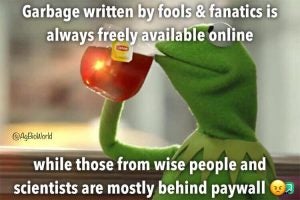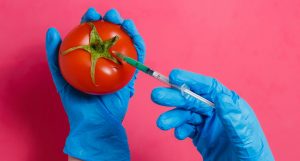How do we know if what we are reading online is true or factual? Particularly if it’s a topic we may not know a lot about? Here are a few tips to decipher fact from fiction when reading an article online:
1. Google it, “debunked.” For example, in agriculture let’s say you read something along the lines of, “GMO wheat is drenched in glyphosate just before harvest!” You can google, “Glyphosate in wheat debunked” and see what comes up. You can also google, “GMO wheat debunked” or anything along those lines. Realize that there is always two sides to every story, but it’s important to understand the source and to actively check for the opposing perspectives — Google’s algorithm shows you results based on your search history and which stories have “owned” certain keywords and are the most accessible, and they’re not always the most trustworthy.

A quick Google search reveals that there’s no such thing as commercially available GMO wheat, and in the rare instance of using glyphosate as a desiccant in wheat, it’s never “drenched” or sprayed in a dangerous or harmful way. Which leads to point No. 2 …
2. Beware of hyperbolic language and scary images. Oftentimes fake news will share words and photos that evoke strong emotions. Words such as “drenched” and “soaked” in “Monsanto’s Roundup” with pictures of gas masks, hazmat suits, needles, gasses, or skulls (that’s not how farming works!). Those and other imagery deserve a place on the internet wall of shame and should never be allowed. Unfortunately, for many, they are protected by freedom of speech and fear sells. Sadness sells, too. Are animals really treated poorly on farms? Or do these sad images make you want to donate to organizations to go vegan? When you read language that sounds a bit much, there’s a really good chance it probably is. Which leads to point No. 3.

3. Who is saying this and why? What do they have to gain? Sadness and fear can sell products or ideology. For example, PETA and HSUS aren’t exactly broke, and they lobby against animal agriculture, zoos, circuses, animal research, and anything else along those lines as they’d like total animal liberation. So if text or video can be overblown or messages can be misleading, this is a great way to gather donations. Of course … if something is actually wrong, we all want to help animals, but double check the source. Ask the farmers, veterinarians, zoologists — you know, the actual experts. Go to the source or “Google the topic, debunked!” Examine all sides of an argument before shelling over your hard-earned cash to donate. Find out what percentage of donations actually go to the cause.
In terms of fear based against other topics like GMOs, chemicals, conventional agriculture. etc., remember that “organic” and “non-GMO” are labels valued at around $85 billion from large food conglomerates. By scaring people about perfectly healthy GMO or conventional foods, those companies have us right where they want us: paying three times more for their labels while generally increasing their activist war chests.
4. Who is the author or journalist? What is their background and who are they affiliated with? Look up any organizations they may work with. Who does the funding for the website — any red flags? This isn’t totally foolproof but can provide a good foundation or basis to understand who they are and what they stand for. Are they an animal-rights activist based in London that’s writing about animal agriculture in the United States? Or are they an actual American farmer writing about it? Look at the author’s firsthand expertise and knowledge on the topic. Sometimes an article may say, “recent studies show …,” but are the studies actually listed and are they peer-reviewed from credible sources? Third-party verified with credible university research can also go a long way.
5. Is the website trying to sell something? Again, fear sells. An alternative health website with poor credentials may use fear and labels to generate revenue, almost like modern snake oil. “XYZ is poison! Food is medicine! Buy my product and save yourself!” Again, check their credentials, Google them debunked (I’m looking at you, “Health Ranger” Mike Adams and Dr. Mercola), and dig deeper to see if they’re actually credible or using hyperbolic language and fake news stories to profit off of misinformation and false alternative health claims.
6. Lastly, visit some fact-checking websites. Activistfacts and snopes.com are a couple you can use to see if the point in question has already been thoroughly investigated and debunked. Yet, even these websites are not perfect, so please don’t even take the info presented at face value, but they can offer a foundation and some points to consider.
For those of us in our 30s or older, when we were kids, our only options to get information were from credible sources. We relied on the library, encyclopedias (who remembers Encyclopedia Britannica?), and our teachers and professors to give us credible information, where fact checking wasn’t a huge part of our daily lives. Nowadays with the internet information highway at our fingertips, anyone can say anything they want and reach hundreds of thousands of people. Use the above six tips to improve our critical thinking abilities and realize everything online is not as it seems, and don’t forget common sense! Seek information from science-based websites, peer review, and real experts in the subject, and you’ll be well on your way to becoming well versed in topics based on credible sources.
Michelle Miller, the Farm Babe, is an Iowa-based farmer, public speaker, and writer, who lives and works with her boyfriend on their farm, which consists of row crops, beef cattle, and sheep. She believes education is key in bridging the gap between farmers and consumers.



